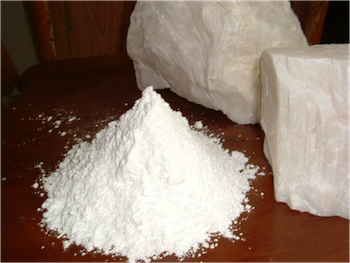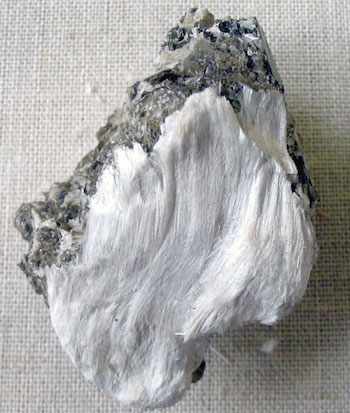 Talc is a mineral that belongs to a class of minerals called silicates. Talc is the softest known mineral on Earth. It is mined from the Earth as rocks, either from underground mines or in pit-mining operations.
Talc is a mineral that belongs to a class of minerals called silicates. Talc is the softest known mineral on Earth. It is mined from the Earth as rocks, either from underground mines or in pit-mining operations.
Talc ore is mined and then ground up into a fine powder, which is then used for a variety of purposes. While many people are most familiar with talc as the main component of talcum powder (which is usually made by simply adding perfume or fragrance to ground talc), talc is also used in various industries, including paper making, plastic, paint and coatings, rubber, food, electric cable, pharmaceuticals, cosmetics, and ceramics.
 Asbestos is a term for fibers made up of two groups of minerals, known to geologists as amphiboles and serpentines. Asbestos fibers can be from the serpentine mineral called chrysotile, and from the amphibole minerals called amosite, tremolite, crocidolite, anthophyllite, and actinolite. Like talc, both serpentine and amphibole minerals are part of the silicate group of minerals.
Asbestos is a term for fibers made up of two groups of minerals, known to geologists as amphiboles and serpentines. Asbestos fibers can be from the serpentine mineral called chrysotile, and from the amphibole minerals called amosite, tremolite, crocidolite, anthophyllite, and actinolite. Like talc, both serpentine and amphibole minerals are part of the silicate group of minerals.
Like talc, asbestos was mined from the Earth and processed into a usable form. When the fibers of the asbestos minerals are woven into material like insulation, they are very resistant to high heat and chemicals, and have a many industrial uses. In the 20th century, asbestos was used in a wide variety of industrial applications. As more asbestos came to be used by industries, people began to notice the health effects that it had on the people who used it. By the mid-20th century, it was known that asbestos could cause a deadly lung scarring disease known as asbestosis, as well as cancer.
Because talc and asbestos are both silicates, they are formed by similar geological conditions, and often form in the same locations in the Earth. In fact, in the right geological conditions, talc can (over millions of years) change into asbestos, and asbestos can change into talc.
When we find talc deposits (or asbestos deposits) in the Earth, talc and asbestos are often both present in the formation. The association between talc and asbestos may not be common knowledge, but it has been known geologists and mineralogists for at least a century.
While the relationship between talc and asbestos has been known for some time, in the past, many companies or industries that mined, sold or used talc either did not check to see if it was contaminated with asbestos, or used methods that were too imprecise to detect small asbestos fibers that could present a health hazard to people exposed to the talc. Sensitive electron microscopy, however, can detect microscopic asbestos fibers in talc.
 There are different ways one could be exposed to asbestos from talc. One way is occupational exposure, which results from working with or around talc that is contaminated with asbestos in an industrial setting. Talc was used in many factories, either as part of the processing of other products or as an ingredient in products such as paint or plastic. Industrial talcs that were in the past mined in New York, California, and Nevada are known to have been contaminated with asbestos.
There are different ways one could be exposed to asbestos from talc. One way is occupational exposure, which results from working with or around talc that is contaminated with asbestos in an industrial setting. Talc was used in many factories, either as part of the processing of other products or as an ingredient in products such as paint or plastic. Industrial talcs that were in the past mined in New York, California, and Nevada are known to have been contaminated with asbestos.
There's also the possibility of asbestos exposure from the use of consumer products containing talc. The main such product is talcum powder. Talcum powders used by men and women for cosmetic or hygiene purposes are known to have been made for many decades from talc deposits which contained asbestos. Some of those talc deposits are in Italy, North Carolina, and Montana.
It's important to recognize that a person does not have to personally use talc in order to be exposed to asbestos from it. Because asbestos fibers are microscopic and aerodynamic, when contaminated talcum powder is used, it can release asbestos fibers that float through the air and are breathed in by people other than the person using it. So you could have been exposed to asbestos if you were near people using talc. Asbestos fibers can also stick to people's clothing and expose people who come into contact with them, so people who washed the clothes of family members who worked with talc may have been at risk.
It's also important to understand that the diseases caused by asbestos can take many decades to develop. Asbestos fibers enter the body and are not broken down, and can remain in the body long after the exposure. So even if you haven't been around talc in a long time, exposures to talc that happened 20-50 years ago may continue to put you at a higher risk of diseases including cancer.
Find out whether you have a case by speaking to one of our experienced talc lawyers via phone at 1-844-TALC123 (1-844-825-2123) or by submitting an email inquiry (see form to the right). Our attorneys will be quick to respond to you and happy to answer all of your questions.




Copyright © 2016 Levy Konigsberg LLP - Talc Lawyers. All rights reserved.
Attorney Advertising: Prior results do not guarantee a similar future outcome.
Levy Konigsberg LLP, 800 Third Avenue, 11th Floor, New York, NY 10022.
Johnson’s® Baby Powder is a trademark of Johnson & Johnson Consumer Companies, Inc. Shower to Shower® is a trademark of Valeant Pharmaceuticals International, Inc. Prior to 2012, it was a trademark of Johnson & Johnson Consumer Companies, Inc. Cashmere Bouquet™ is a trademark of Colgate-Palmolive Company. Desert Flower was formerly a trademark of Shulton, Inc.